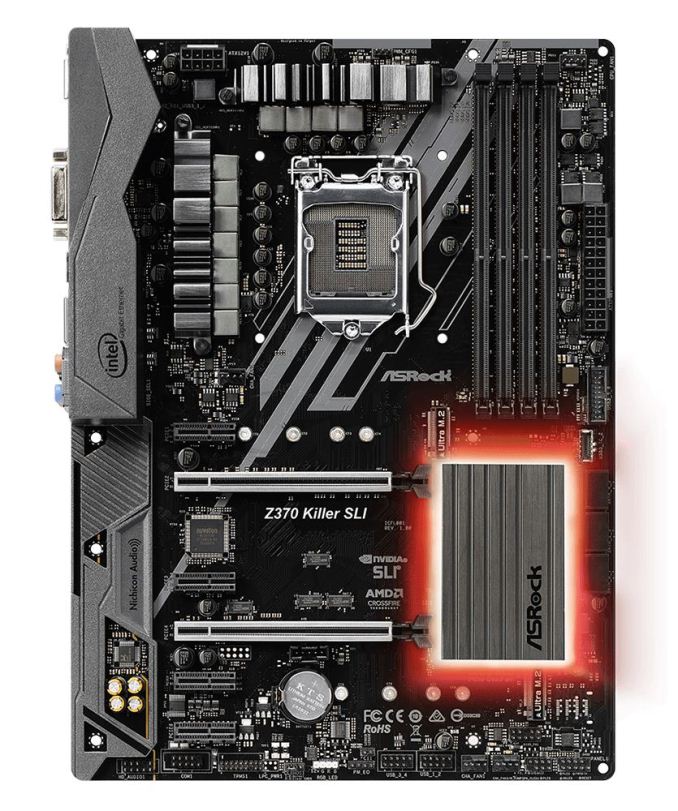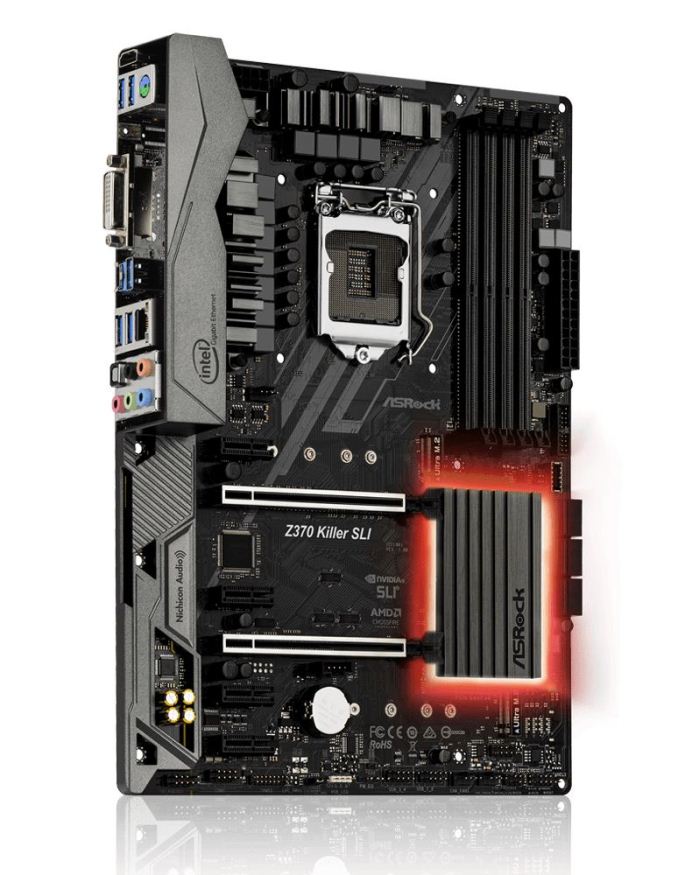Analyzing Z370 for Intel's 8th Generation Coffee Lake: A Quick Look at 50+ Motherboards
by Ian Cutress, Anton Shilov, Joe Shields & Gavin Bonshor on October 20, 2017 2:00 PM ESTASRock Z370 Killer SLI and Killer SLI AC
The ASRock Z370 Extreme line consists of the Z370 Killer SLI/ac, Killer SLI, and the Extreme4. Both of the Killer SLI boards will be covered on this page as the only difference between the two is the wireless LAN which comes with the SLI/ac. Some of the differences between the Gaming line and the Extreme line are the power delivery, different controllers/caps/chokes, different heatsinks, and controller choice allowing for cost-saving efforts to keep the price to the consumer lower than the Gaming or Professional branded motherboards.
Both the Killer SLI and SLI/ac look exactly the same outside of the back panel IO where the ac model has the Intel Wi-Fi card out back. The shared board otherwise is an all-black affair, outside of some artwork on the PCB going through the socket area. The chipset heatsink is more of a simple rectangle on the Killer boards compared to the Gaming boards, and has RGB LEDs below it. An RGB header is located on the bottom of the boards for adding another LED strip. Shrouding covers the back panel and audio sections, while the last design aesthetic that sticks out is the two full-length reinforced PCIe slots.
The four memory slots support the platform maximum of 64 GB, with supported speeds up to DDR4-4266. That value is still faster than most boards covered in the roundup, but one notch below the high-end ASRock boards. There are two full-length reinforced slots fed from the CPU, capable of x16 and x8/x8 connectivity, and four x1 slots from the chipset. Both 2-way SLI and 3-way Crossfire are supported (as well as quad SLI/Crossfire with dual GPUs).
The Killer SLI and SLI/ac both include six SATA ports supporting RAID 0, 1, 5, and 10. Additional storage is handled by two M.2 slots; the first is located above the top full-length PCIe slot and supports drives up to 80mm, while the second is located towards the bottom of the board below the chipset heatsink and supports drives up to 110mm. Be aware of slot sharing; if the first M.2 slot is occupied by a SATA device, SATA5 will be disabled, while if the second M.2 slot is occupied by a SATA module, SATA0 will be disabled.
Fan control is handled through the BIOS or via the F-Stream software, and gives control to all the fan headers: a CPU fan header (1A/12W), two chassis Fan headers, and a chassis optional/water pump header (1.5A/18W). Audio duties are handled by the last generation ALC892 codec, but is upgraded with the use of Nichicon Gold series audio caps. Network connectivity is handled by a single Intel I219-V on both boards with the SLI/ac adding the Intel Wi-Fi module for wireless support. The online specifications do not state which Wi-Fi module this is, although it is likely to be the AC3165.
USB connectivity is the same on both boards with neither utilizing the USB 3.1 (10 Gbps) controllers. On the back panel there are five USB 3.1 (5 Gbps) ports and one Type-C port. Additionally, there are two internal USB 2.0 headers supporting four ports, and another internal USB 3.1 (5 Gbps) header yielding two more ports. All USB ports are handled by the chipset. The back panel IO also has two video outputs with an HDMI and DVI-D port, as well as a 5 plug audio stack plus SPDIF. The Killer SLI/ac is the one with the Intel Wi-Fi antenna ports out back as well.















83 Comments
View All Comments
weevilone - Wednesday, October 25, 2017 - link
Notable that though the new boards are often very similar to their Z270 predecessors, Asus has dropped Thunderbolt 3 support from the Maximus X Hero board.masouth - Thursday, October 26, 2017 - link
ASUS ROG Z370 Maximus X Hero"....new metallic heat sinks that are an upgrade over the plastic heatsinks found on the Z270 version"
Please excuse my ignorance because I didn't own a ROG Z270 mb but...plastic HEAT SINKS? Not shrouds or decoration over a heat sink but the actual heat sinks themselves? That's either wrong, they performed their job pretty poorly, or plastic resins have advanced a lot farther in thermal conductivity (and cost for such) than I realized.
flowrush - Sunday, November 19, 2017 - link
"The other main distinguishable feature is the inclusion of integrated 802.11ac Wi-Fi with an antenna (that can only be described as a shark fin) found on the F."The above is incorrect in the article. The integrated Wi-Fi module with antenna is found on the E not the F.
Coldgame - Saturday, November 25, 2017 - link
I'm looking to build a rig with the Z370 Gaming ITX/ac, a GTX-1070 card and an Apple Thunderbolt Display.The review states:
"The key difference in the support between the two boards is going to be the Thunderbolt 3 port on the Gaming-ITX. This port supports video outputs..."
So, can anyone confirm or deny that video generated by the GTX-1070 can be output through the onboard Thunderbolt 3 port?
hanselltc - Sunday, December 3, 2017 - link
Looking forward to low-middle end mITX choices from this platform. It'll probably be paired with a 8100/8300 and be my secondary machine.Roen - Sunday, February 4, 2018 - link
Where are the 10 Gbps ports on the back? They all look like 5 Gbps ports, even the Type C.rbarak - Wednesday, February 21, 2018 - link
Is anyone using the Z370-P on Linux with two screens?I built a new machine based on the Z370-P, and both the DVI and the HDMI connected screens show the same image, and the RHEL7 setup/displays show only one Unknown Display.
I follwed the advice on stackexchange, and added this line:
$ grep GRUB_CMDLINE_LINE_DEFAULT /etc/default/grub
GRUB_CMDLINE_LINE_DEFAULT="i915.alpha_support=1"
Then I did:
sudo grub2-mkconfig -o "$(readlink /etc/grub2.conf)"
And rebooted, but still, the two displays are not shown.
dromoxen - Wednesday, May 9, 2018 - link
Shocked to see that both the Asrock mitx boards are "szie=ATX" .. LOLThe addition of Tunderbolt sure seems to add a hefty premium £120 vs £160 , luckily I can do without.
Kroebo - Sunday, October 7, 2018 - link
Sadly, I discovered that the ZUG Gaming PLUS doesn't support SLI.trag - Tuesday, January 15, 2019 - link
On the ASrock Z370M Pro4 the M.2 slot information is backwards. Both slots support NVME. One slot also supports SATA. As written, "The first M.2 slot is SATA only while the second supports PCIe." it seems to say that one slot is SATA only and the other slot is PCIe (NVME) only.